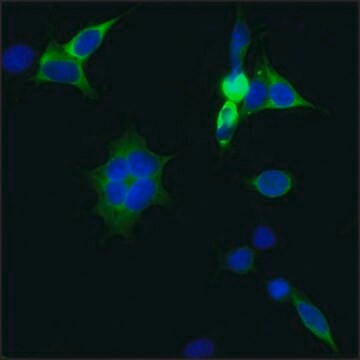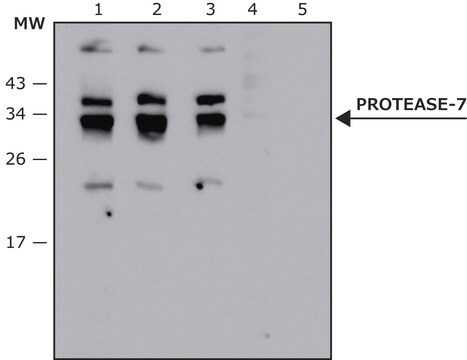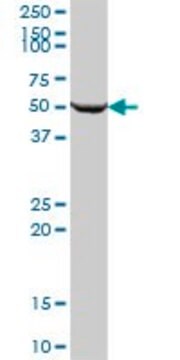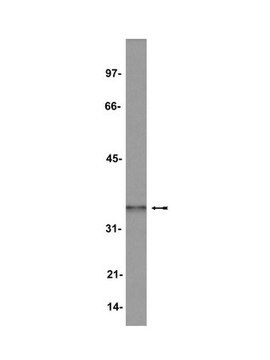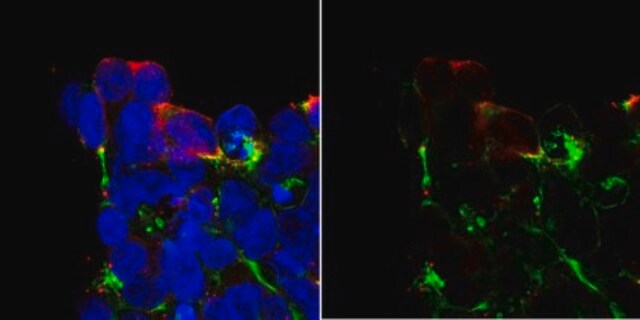Kluczowe dokumenty
SAB4200756
Przeciwciało anty-AsCas12a (Cpf1), mysie monoklonalne
clone AsCpf-11, purified from hybridoma cell culture
Synonim(y):
Endonukleaza AsCas12a związana z anty-CRISPRz Acidaminococcus sp. (szczep BV3L6), Przeciwciało anty-AsCpf1, mysie monoklonalne
About This Item
Polecane produkty
pochodzenie biologiczne
mouse
Poziom jakości
forma przeciwciała
purified from hybridoma cell culture
rodzaj przeciwciała
primary antibodies
klon
AsCpf-11, monoclonal
Formularz
buffered aqueous solution
masa cząsteczkowa
~135 kDa
stężenie
~1.0 mg/mL
metody
immunoblotting: 1.25-2.5 μg/mL using purified recombinant AsCpf1 produced in E. coli
immunofluorescence: 1.25-2.5 μg/mL using human HEK-293T cells over-expressing AsCpf1 protein
immunoprecipitation (IP): 2.5-5 μg/test using lysate of human HEK-293T cells over-expressing AsCpf1 protein
izotyp
IgG2a
numer dostępu UniProt
Warunki transportu
dry ice
temp. przechowywania
−20°C
docelowa modyfikacja potranslacyjna
unmodified
Opis ogólny
Cpf1 (CRISPR from Prevotella and Francisella 1) należy do systemu endonukleazy CRISPR-Cas typu V klasy 2.4-5 Cpf1 zawiera kilka różnic w porównaniu z białkiem Cas9, w tym rozszczepienie z 5′overhangs, krótszy prowadzący RNA i większą odległość między sekwencją nasienną a miejscem rozszczepienia.
AsCpf1, Cpf1 z Acidaminococcus sp. (szczep BV3L6), został przebadany wraz z 15 członkami rodziny nukleaz Cpf1 i wykazano, że pośredniczy w wydajnej edycji genomu w komórkach HEK293FT z lepszymi wynikami w porównaniu do SpCas9.5 Struktura krystaliczna AsCpf1 w kompleksie z crRNA i częściowo zduplikowanym docelowym DNA pokazuje, że AsCpf1 działa jako monomer, identyfikując w ten sposób unikalny mechanizm stosowany przez AsCpf1 do rozpoznawania celu.
Immunogen
Zastosowanie
- immunoblotting (~135 kDa),
- immunofluorescencja
- immunoprecypitacja
Przeciwciało monoklonalne anty-AsCpf1 może stanowić użyteczne narzędzie do badań nad edycją genomu, takich jak wykrywanie i monitorowanie pozytywnie transfekowanych komórek AsCpf1.
Postać fizyczna
Przechowywanie i stabilność
Inne uwagi
W celu uzyskania najlepszych wyników w różnych technikach i preparatach zalecamy określenie optymalnego stężenia roboczego za pomocą testu miareczkowania.
Nie możesz znaleźć właściwego produktu?
Wypróbuj nasz Narzędzie selektora produktów.
Kod klasy składowania
10 - Combustible liquids
Temperatura zapłonu (°F)
Not applicable
Temperatura zapłonu (°C)
Not applicable
Wybierz jedną z najnowszych wersji:
Certyfikaty analizy (CoA)
Nie widzisz odpowiedniej wersji?
Jeśli potrzebujesz konkretnej wersji, możesz wyszukać konkretny certyfikat według numeru partii lub serii.
Masz już ten produkt?
Dokumenty związane z niedawno zakupionymi produktami zostały zamieszczone w Bibliotece dokumentów.
Nasz zespół naukowców ma doświadczenie we wszystkich obszarach badań, w tym w naukach przyrodniczych, materiałoznawstwie, syntezie chemicznej, chromatografii, analityce i wielu innych dziedzinach.
Skontaktuj się z zespołem ds. pomocy technicznej


